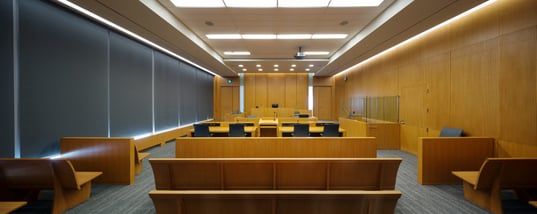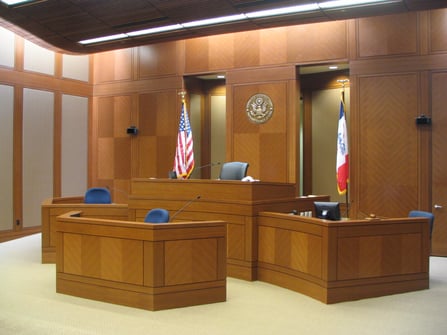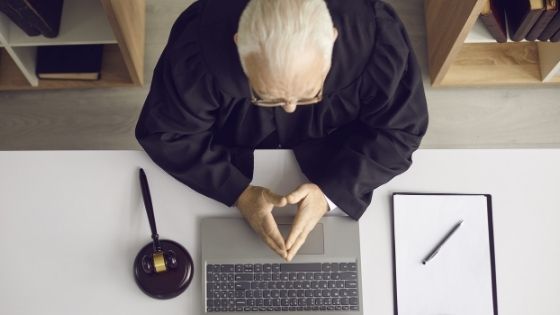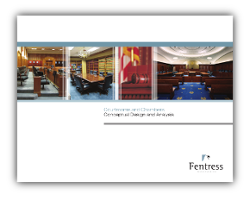Courtroom sharing is a sensitive topic for many courts. Although some courts have implemented courtroom sharing practices, many remain resistant to the concept and are still planning courthouses that include a dedicated courtroom for every judge. I would like to suggest that the COVID pandemic has highlighted opportunities to reduce the need for courtroom space that could, in turn, allow for increased courtroom sharing among judges.
During the pandemic, many courtrooms have remained underused or even empty while cases have continued to be heard. While some courts have delayed trials, the greatest reason for the underutilized courtroom space is the prevalence of videoconferencing during the pandemic. When courts fully resume operations, many believe that judges will continue to use videoconferencing on a regular basis. Thus, when planning for future court projects, is there an opportunity to incorporate courtroom sharing and reduce the number of courtrooms that may be needed?
Reasons Not to Share
Before we discuss the reasons for courtroom sharing, let’s consider the reasons many courts are resistant to this idea.
Tradition. Traditionally, courthouses are constructed with one courtroom per judge. The courtroom is typically built in close proximity to the judge’s chambers. Therefore, the space is designed for a judge to use a dedicated courtroom next to his or her dedicated chambers.
Multiple Uses of the Courtroom. The nature of court proceedings, including the length of trials, is often unpredictable. A courtroom needs to be available for the full length of a multi-day proceeding as well as for the frequent impromptu proceedings and brief meetings that keep the judicial process moving.
Promoting Justice. The courtroom is a tool used for the administration of justice. Having a dedicated courtroom that can be used when needed reduces the risk of scheduling conflicts that delay the judicial process, and protects against proceedings being adversely affected by courtroom availability issues.
Reasons to Share
Now let’s explore some of the reasons to engage in courtroom sharing.
Cost Savings. It often costs several million dollars to build a courtroom set that includes the courtroom, attorney/witness conference rooms, holding cells, prisoner interview room, and jury room with associated facilities. When building a new courthouse, the number of courtrooms is a key factor in determining the ceiling height and overall footprint of the building. Courtroom sharing can dramatically reduce the scope of a renovation or new construction project and its corresponding budget.
Assign Courtrooms by Proceeding Type. If a courthouse already has multiple courtrooms, sharing can allow courtrooms to be assigned based on the size needed for a particular type of proceeding. For example, judges could share a large, multi-purpose courtroom for high-profile cases that draw numerous spectators, or for multi-defendant proceedings or jury trials. Similarly, judges could share smaller courtrooms for smaller proceedings or to provide parties with a less imposing setting (e.g., for family court). Sharing courtrooms in this way does not always result in a reduced number of courtrooms, but it does promote the assignment of courtrooms based on the type and size of proceeding.
Security. Courtrooms that are used for criminal proceedings have tighter security requirements than those used for non-criminal proceedings. These courtrooms must incorporate separate prisoner circulation routes, adjacent holding cells, etc. Courtroom sharing allows some courtrooms to be designed without all of these security features, which can reduce the overall size and cost of a renovation or construction project.

Impact of the Pandemic
During the pandemic, the wheels of justice have continued to turn with the help of videoconferencing while many courtrooms have remained shuttered with the lights out. Many courts at the local, state, and federal levels have embraced videoconferencing technology for many different types of court proceedings and trials.
This is not to say that courtrooms won’t be “lights on” when pandemic restrictions fully lift. While videoconferencing has provided a critical relief valve during the pandemic, and should continue to serve a role in the future, not all proceedings are suitable for videoconference. Furthermore, many courts across the nation are now faced with a significant backlog of cases. Complicating matters even further is the current recession, which is expected to result in increased case filings for most case types. In many courts, it will take several years to alleviate the backlog and to return to “business as usual.”
But videoconferencing has provided judges with much-needed mobility during the pandemic, allowing them to conduct court proceedings from their courtrooms (with the parties attending remotely), chambers, and even their homes. One thing this pandemic has made clear is that a judge does not always need a courtroom to conduct a proceeding.
In my opinion, the widespread use of videoconferencing for court proceedings should continue in the future due to the convenience and cost savings it provides. There is no doubt that videoconferencing technology will continue to evolve and will incorporate enhanced reliability and security, and will offer additional functionality. Courts that keep up with the changing technology can truly benefit.
While I have not heard a judge indicate that he or she would prefer videoconferencing trials over in-person trials for the long term, almost all judges I’ve spoken to have said that the use of videoconferencing for certain court proceedings should – and will – continue long after the pandemic ends. This expanded use of videoconferencing will make some courtrooms available for sharing. Let’s take a look at how to determine whether your court is a candidate for sharing.
Making a Sharing Decision for Your Court
I do not recommend constructing fewer courtrooms than judges for small courthouses with one to four judges. However, the more judges that are resident in a courthouse, the greater the opportunity for sharing. Below are some considerations to help your court evaluate your courtroom needs and the opportunities that may exist to incorporate sharing practices.
A Mix of Courtroom Types
A key component in the decision on courtroom sharing is determining the different types of courtroom spaces you need as well as the frequency each type is generally needed. Consider factors such as the frequency of jury trials, number of criminal and multi-defendant proceedings, and different case types (e.g., initial appearance, domestic, juvenile, etc.). Next, consider the various types of courtroom sizes and layouts that are possible, and which are most suitable for the various types of proceedings. Many proceedings do not require a full-size courtroom, and could be accommodated in a mid-sized courtroom or even a much smaller videoconference hearing room. These hearing rooms have the trappings of a courtroom to lend dignity to the proceedings, but are not designed to accommodate multiple parties, in-custody defendants, or numerous spectators. A thorough analysis will help your court determine where there are opportunities to more closely align case type with the type and size of courtroom.

Courtroom Utilization Studies
The ideal method for determining the appropriate number and mix of courtrooms and videoconference hearing rooms is a courtroom utilization study that tracks the hours judges spend in each proceeding, as well as the type of proceeding and number of courtroom participants. Such a study provides rich detail on actual courtroom usage and can be used to project courtroom needs into the future. However, many courts struggle to keep accurate records due to the dynamic environment and nature of proceedings. Thus, reliable data on judge bench hours and courtroom usage can be difficult to find.
If a full courtroom utilization study is not feasible, I suggest tracking utilization through observation. One way to do this is to assign staff the task of walking past the courtrooms four times per day for four weeks to observe whether the courtrooms are occupied. You could also have staff estimate the number of people in each courtroom to gain a sense of occupancy levels.
The observations should be conducted when the court is under normal operations – not during the pandemic, summertime, or winter holidays. The observation times should vary slightly each day. It would be best to set up at least three different daily schedules that rotate. Typical fluctuations in court schedules and volume of occupants should also be taken into consideration when planning the observations.
Over the course of a month, the observations should help you determine how often the courtrooms are in use during the peak hours between 9 AM and 5 PM. In courts with high utilization, courtrooms are generally considered to be occupied 70-80% or more of the time. Such courts provide little opportunity for sharing.
It’s more common for courtrooms to be in use 50-70% of the time. In these courts, it is possible for four judges to share three courtrooms with a degree of confidence that a courtroom will be available when needed. Courts with a utilization rate below 50% could have three judges share two courtrooms with a degree of confidence. I hesitate to recommend two judges per courtroom given the conflicts that can arise in scheduling court proceedings. The exception would be for judges working part-time hours.
Videoconference Hearing Rooms
I would suggest including videoconference hearing rooms in lieu of some or all courtrooms that are eliminated due to sharing. For example, if there are 10 judges in a court with a 60% utilization rate, the ratio of three courtrooms for every four judges (75%) could be applied, resulting in eight courtrooms (always round up – 10 judges x 0.75 sharing ratio = 7.5 courtrooms, or 8 rounding up). I would suggest adding two videoconference hearing rooms - one for each of the courtrooms not constructed - to support the practice of sharing.
As another example, if there are 10 judges and the utilization rate is 40%, the ratio of two courtrooms for every three judges (66%) could be applied, resulting in seven courtrooms (10 judges x 0.66 sharing ratio = 6.6 courtrooms, or 7 rounding up). I would suggest adding three videoconference hearing rooms in place of the three courtrooms eliminated due to sharing.
These guidelines provide a general rule of thumb for courtroom sharing and should be tailored to the unique needs of your court.
Can Sharing Work?
Sharing will not work in all cases. The culture of the court, along with the volume and type of proceedings, must be taken into consideration. I am currently working with a court where sharing is possible based on utilization rates and the use of videoconferencing, but the court feels strongly that they should maintain the ratio of one courtroom per judge. Courtroom sharing simply does not work with their culture today, though I would encourage them to stay open to the possibility in the future, especially when expansion may be needed.
In another recent project, we helped a court plan a collegial chambers arrangement, where chambers are clustered together on a single floor rather than being placed directly adjacent to individual courtrooms. In this arrangement, four judges successfully share three courtrooms and a small hearing room.
A significant amount of courtroom sharing happens in the federal courts. As a matter of fact, the design standards for federal courthouses incorporate sharing for senior district judges, magistrate judges, and bankruptcy judges in all new courthouse construction projects. These sharing arrangements were resisted at first, but sharing is being implemented throughout the federal court system with great success.
The widespread use of videoconferencing throughout the pandemic points to an even greater potential for courtroom sharing in the future. I encourage courts to embrace the technology that is driving our future and to consider how courtroom sharing through the increased use of videoconferencing can benefit both the taxpayer and the court over the long term.
____________________________________________________
Click on the image below for our courtroom and chambers eBook






.jpg)
.jpg)
.jpg)
.jpg)
.jpg)
.jpg)


-1.jpg)
.jpg)
.jpg)
.jpg)

